The fall of Vuhledar is a microcosm of Ukraine's wartime predicament
SAMYA KULLAB and VOLODYMYR YURCHUK
Updated Wed, October 2, 2024
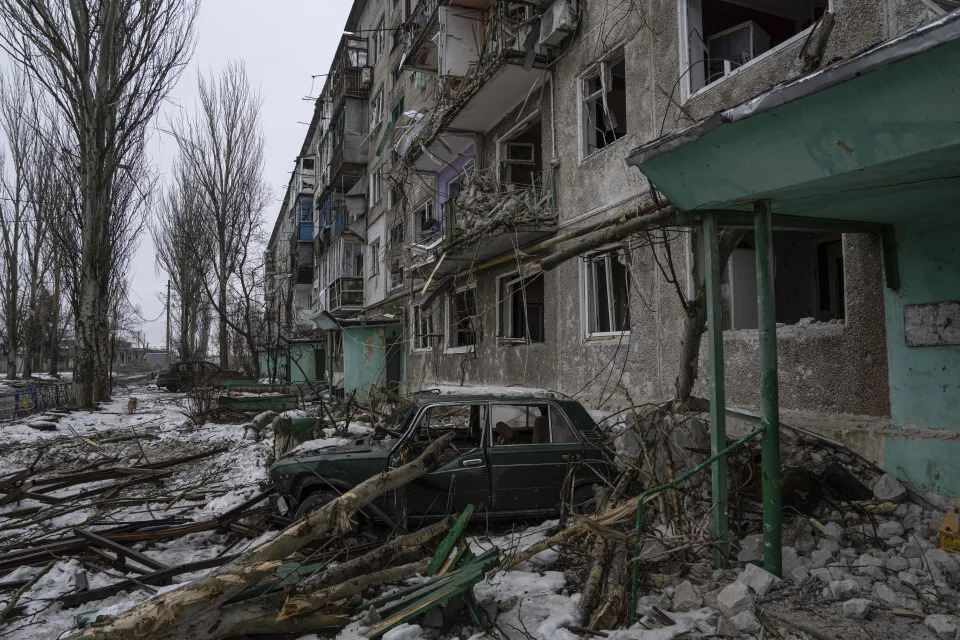
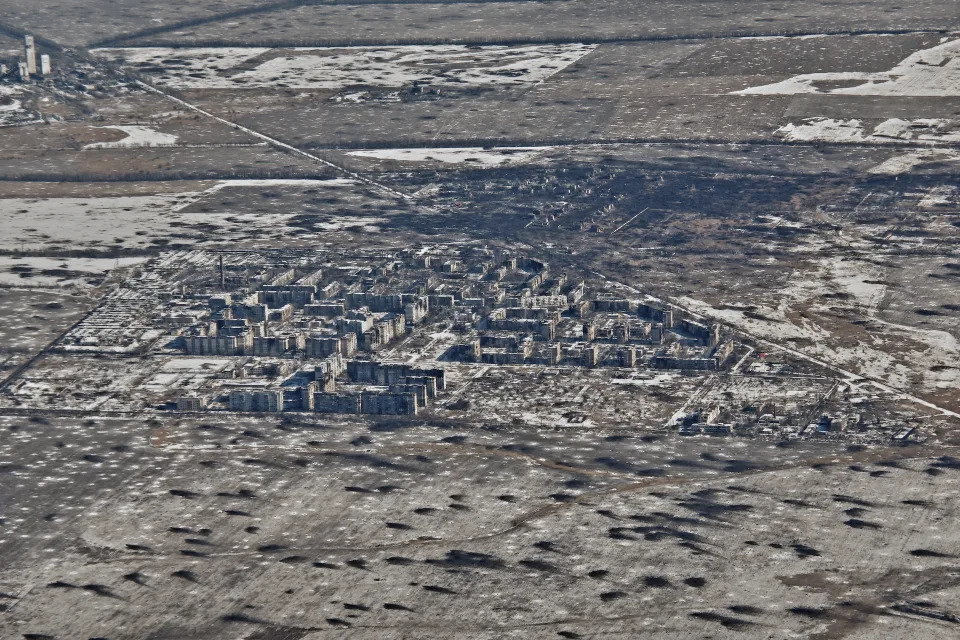
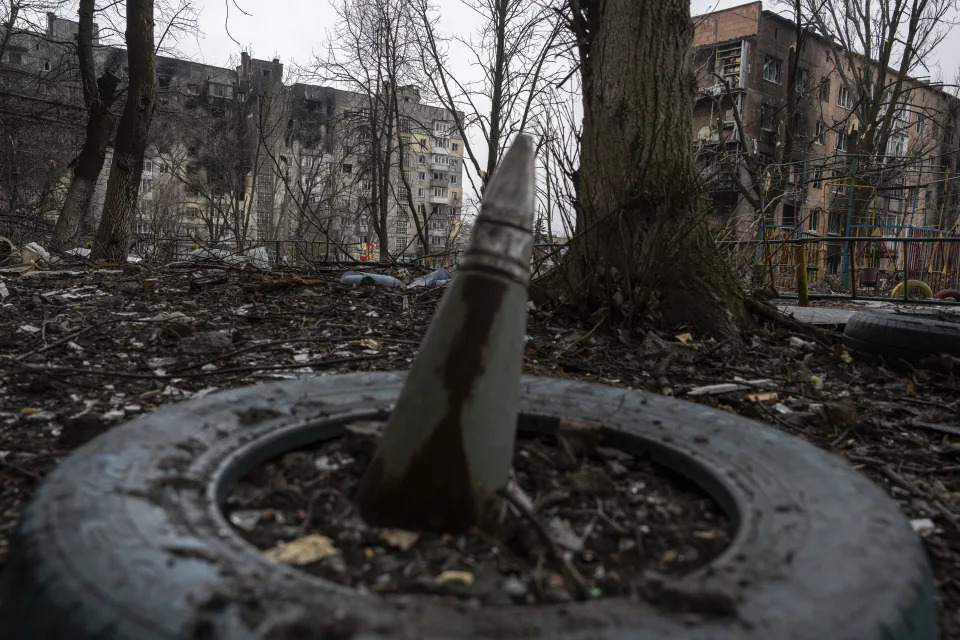
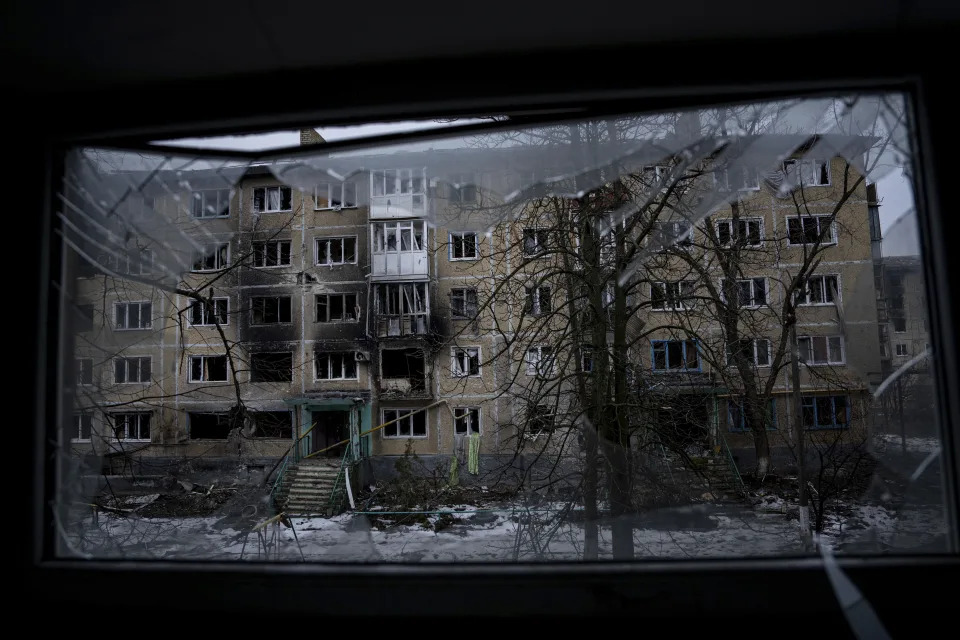
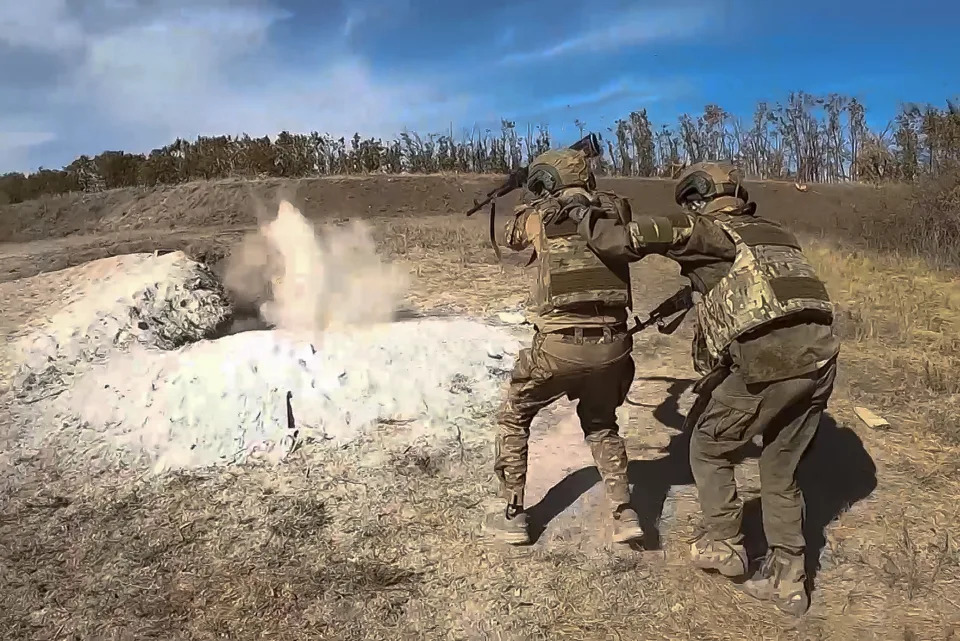
An aerial view of Vuhledar, the site of heavy battles with the Russian troops in the Donetsk region, Ukraine, Feb. 10, 2023. (AP Photo/Libkos, File)
KYIV, Ukraine (AP) — The fall of a front-line town nestled atop a tactically significant hill is unlikely to change the course of Ukraine’s war against Russia. But the loss underscores Kyiv’s worsening position, in part the result of firm Western red lines, military officials and analysts said.
Vuhledar, a town Ukrainian forces fought tooth and nail to keep for two years, is the latest urban settlement to fall to the Russians. It follows a vicious summer campaign along the eastern front that saw Kyiv cede several thousand square kilometers (miles) of territory.
Ukraine’s military said they were withdrawing their troops from Vuhledar to “protect the military personnel and equipment" in a statement on Wednesday.
Vuhledar's fall is a microcosm of Ukraine’s predicament in this chapter of the nearly three-year war. It reflects the U.S.'s refusal to grant Ukraine permission to strike targets deep inside Russian territory, preventing Kyiv from degrading Moscow’s capabilities. Meanwhile, Russia's dominance of the skies allows it to develop and advance devastating aerial glide bombs for which Ukraine has no effective response, while a controversial mobilization drive has failed to produce a new class of Ukrainian fighters capable of holding the line.
The Ukrainians' retreat from the town comes after a much-anticipated visit by Ukrainian President Volodymyr Zelenskyy to the U.S. last week. The Biden administration so far has refused Kyiv’s request to use Army Tactical Missile Systems, or ATACMS, to strike Russian airfields and other key targets, and Zelenskyy’s “victory plan,” was dismissed by some as more of a wish list than a plan of action.
In the meantime, Russian fighter jets continued to drop aerial bombs on Vuhledar, which precipitated the retreat, soldiers there said.
“(The Russians') main tactic was to encircle us from the flanks, and they did this constantly for six to seven months with constant aerial attacks — due to this tactic they managed to exhaust our resources, because we don’t have as much as they have,” said Arsenii Prylipka, the head of the press office of the 72nd Brigade, which had been defending Vuhledar since August 2022.
The fight for Vuhledar
After two years of failed attempts to capture Vuhledar, Russian forces switched tactics earlier this year. The town’s pre-war population of 14,000 dwindled to less than 100 during the heat of the fighting.
Russian soldiers began mounting sophisticated attacks from the north and southern flanks, powered by superior electronic warfare capabilities and an array of infantrymen on motorcycles, artillery fire, drones and aerial glide bombs. Moscow suffered heavy causalities.
Ukrainians have been pressuring the U.S. to relax restrictions on the use of Western weapons to strike targets deep inside Russia. Lawmakers said they expected a green light from the U.S. months ago, but it didn’t come: The Biden administration refused to waver on this red line.
It has meant that Russian command and control centers, logistics hubs and airfields from which Russian fighter jets carry deadly aerial glide bombs, are out of reach of Ukrainian forces.
Russia fires nearly 120 aerial bombs a day on average, about 3,000 a month. The bombs are Soviet-era weapons refitted with navigational technology.
“We cannot change the dynamics, and the Russians are pushing,” said Pavel Narozhnyi, founder of the non-profit Reactive Post, which sources spare parts for artillery.
Month after month of constant attacks eventually eroded Ukrainian defenses.
After two years of intense fighting, the 72nd Brigade — which never rotated out due to the intensity of the fight and the lack of a demobilization strategy from Ukrainian military leaders — withdrew from the patch of land many of their comrades died to defend.
Prylipka had said the brigade would stay until the very last moment when defending Vuhledar became impossible. That scenario unfolded this week.
“The Russians searched for weak spots in our defenses, a constant probe to find routes to penetrate the town and as they advanced they tried to destroy the entire town. All the time we are under fire,” said Prylipka.
Vuhledar served as a defensive stronghold, a fortress town atop a hill surrounded by open fields and near two major roads. From there, Ukrainian soldiers were able to observe approaching Russian forces at a distance. From that vantage point, it was easy to coordinate counter-attacks. That advantage now falls to Russian forces.
While tactically significant, Vuhledar isn’t a crucial logistics hub for Kyiv, and Russian forces already controlled most of the main roads through the town before capturing it, the U.S.-based Institute for the Study of War said. Ukraine’s access to other critical supply lines remains intact.
The road to Pokrovsk
The capture of Vuhledar is part of Moscow’s pursuit of the strategic logistics hub of Pokrovsk, just 30 kilometers (19 miles) north. Its fall would severely compromise Ukrainian defenses.
The next step for Russian forces will be to drive Ukrainian forces out of the nearby city of Kurakhove.
“This line is interconnected and the enemy will not be able to enter Pokrovsk and come close to Pokrovsk unless it can drive our troops out of Kurakhove," said Ivan Tymochko, chairman of the Council of Reservists of Ukraine’s ground forces. "Otherwise, (the Russians) would have exposed their fronts to the flanks and would have received a serious blow to the side.”
“On the other hand, the enemy understands that if it does not take Kurakhove, it will not be able to seriously influence the course of events around Vuhledar," he added.
The fall of Vuhledar: Ukrainian forces withdraw after two and a half years of fighting
Sasha Vakulina
EURONEWS
Wed, October 2, 2024
Kyiv forces have withdrawn from the town of Vuhledar in the Donetsk region, Ukrainian military command confirmed on Wednesday.
According to the crowd-sourced monitoring website DeepState, Russian soldiers entered the coal-mining city in the Donbas on Tuesday, advancing from the West and South.
The US-based think tank Institute for the Study of War (ISW) reported earlier that Moscow's forces have also been advancing northeast of the town.
Geolocated footage published on Monday and Tuesday shows Russian forces planting Russian flags and freely operating in various parts of Vuhledar, and Russian military bloggers claimed on Tuesday that Russian forces seized the settlement.
Donetsk regional governor Vadym Filashkin said the situation on Tuesday was "very difficult". “The enemy is already nearly in the centre of the city," he told Ukrainian TV.
By Wednesday, the Khortytsia army group officially announced that Ukrainian forces had withdrawn.
"The higher command authorized a manoeuvre to withdraw units from Vuhledar in order to save personnel and military equipment and take up a position for further operations," the group said.
Related
No running water, no electricity, no armed forces: Vuhledar in Donetsk region broken by ongoing war
The storm of Vuhledar: Russian forces threaten from three sides
Ukraine's 72nd Mechanised Brigade has defended the town for nearly two years.
The scale of Ukrainian casualties is unknown at this time, however, an orderly withdrawal likely helped avoid greater casualties.
What is next for Russian forces?
Russian troops have been attempting to capture the town since the start of the full-scale invasion in early 2022. Vuhledar withstood numerous attacks in recent months and weeks as Moscow's forces tried to encircle the town.
The ISW said it is unclear if Russian forces will make rapid gains beyond Vuhledar in the immediate future.
Now, they will have to first completely clear the town "to make it a useable position from which they can launch future assaults," ISW added, with Ukrainian defensive positions situated northeast of Vuhledar.
ISW previously assessed that Moscow's seizure of Vuhledar is unlikely to fundamentally alter the course of offensive operations in western parts of the Donetsk region, mainly because Vuhledar is not a particularly crucial logistics node, and Russian forces controlled most of the main roads running into Vuhledar even before Tuesday.
This means that Russian forces already could interdict Ukrainian logistics in this part of the front to some extent.
Why is Vuhledar important?
Vuhledar's strategic importance lies in its location. The town sits on higher ground between the two fronts: eastern and southern.
To the south, Vuhledar was the last fortified town before the village of Velyka Novosilka and the entire southern part of the Donetsk region that Ukraine controls.
The town is roughly 40 kilometres east of the administrative border with the Zaporizhzhia region. Controlling Vuhledar would also help Russian forces improve their railway logistics, which might help them advance further.
Moscow's primary target remains the town of Pokrovsk, some 50 kilometres north of Vuhledar. Although threatening Pokrovsk's southern flank, Russian forces would need to manoeuvre across open terrain to meaningfully support offensive operations southeast of Pokrovsk.
Advancing across an open field area during the upcoming mud season would complicate matters for Russian forces. It is possible that the Ukrainian military command factored the weather aspect into the decision to withdraw its forces from Vuhledar.
And while it won't be an issue for Russian forces to take full control of the town now, the muddy roads and fields would be almost unusable for mechanised assaults should Russian forces decide to advance further.
They might decide to wait for the ground to freeze before considering the next steps, which would happen in about a month in southern part of Ukraine's Donetsk region.
Wed, October 2, 2024
Kyiv forces have withdrawn from the town of Vuhledar in the Donetsk region, Ukrainian military command confirmed on Wednesday.
According to the crowd-sourced monitoring website DeepState, Russian soldiers entered the coal-mining city in the Donbas on Tuesday, advancing from the West and South.
The US-based think tank Institute for the Study of War (ISW) reported earlier that Moscow's forces have also been advancing northeast of the town.
Geolocated footage published on Monday and Tuesday shows Russian forces planting Russian flags and freely operating in various parts of Vuhledar, and Russian military bloggers claimed on Tuesday that Russian forces seized the settlement.
Donetsk regional governor Vadym Filashkin said the situation on Tuesday was "very difficult". “The enemy is already nearly in the centre of the city," he told Ukrainian TV.
By Wednesday, the Khortytsia army group officially announced that Ukrainian forces had withdrawn.
"The higher command authorized a manoeuvre to withdraw units from Vuhledar in order to save personnel and military equipment and take up a position for further operations," the group said.
Related
No running water, no electricity, no armed forces: Vuhledar in Donetsk region broken by ongoing war
The storm of Vuhledar: Russian forces threaten from three sides
Ukraine's 72nd Mechanised Brigade has defended the town for nearly two years.
The scale of Ukrainian casualties is unknown at this time, however, an orderly withdrawal likely helped avoid greater casualties.
What is next for Russian forces?
Russian troops have been attempting to capture the town since the start of the full-scale invasion in early 2022. Vuhledar withstood numerous attacks in recent months and weeks as Moscow's forces tried to encircle the town.
The ISW said it is unclear if Russian forces will make rapid gains beyond Vuhledar in the immediate future.
Now, they will have to first completely clear the town "to make it a useable position from which they can launch future assaults," ISW added, with Ukrainian defensive positions situated northeast of Vuhledar.
ISW previously assessed that Moscow's seizure of Vuhledar is unlikely to fundamentally alter the course of offensive operations in western parts of the Donetsk region, mainly because Vuhledar is not a particularly crucial logistics node, and Russian forces controlled most of the main roads running into Vuhledar even before Tuesday.
This means that Russian forces already could interdict Ukrainian logistics in this part of the front to some extent.
Why is Vuhledar important?
Vuhledar's strategic importance lies in its location. The town sits on higher ground between the two fronts: eastern and southern.
To the south, Vuhledar was the last fortified town before the village of Velyka Novosilka and the entire southern part of the Donetsk region that Ukraine controls.
The town is roughly 40 kilometres east of the administrative border with the Zaporizhzhia region. Controlling Vuhledar would also help Russian forces improve their railway logistics, which might help them advance further.
Moscow's primary target remains the town of Pokrovsk, some 50 kilometres north of Vuhledar. Although threatening Pokrovsk's southern flank, Russian forces would need to manoeuvre across open terrain to meaningfully support offensive operations southeast of Pokrovsk.
Advancing across an open field area during the upcoming mud season would complicate matters for Russian forces. It is possible that the Ukrainian military command factored the weather aspect into the decision to withdraw its forces from Vuhledar.
And while it won't be an issue for Russian forces to take full control of the town now, the muddy roads and fields would be almost unusable for mechanised assaults should Russian forces decide to advance further.
They might decide to wait for the ground to freeze before considering the next steps, which would happen in about a month in southern part of Ukraine's Donetsk region.
Russia appears to have seized a Ukrainian town after almost 2 years of trying
Mia Jankowicz
Updated Wed, October 2, 2024

Russia appears to have seized a Ukrainian town after almost 2 years of trying
Russia appears to have finally seized Vuhledar, a key frontline town in eastern Ukraine.
The town has been under attack since early in the war, with intense fighting from January 2023.
The town's strategic location may provide a boost to Russia — after at least 18 months of fighting.
Russia appears to have gained control over a key Ukrainian frontline town, military experts said, as the town's governor described a difficult situation for Ukraine there.
Citing open sources and pro-Russian military bloggers, the Institute for the Study of War said that as of Tuesday, "Russian forces likely seized Vuhledar."
Russian forces have been seen moving freely about the town and planting flags there, the ISW reported.
Vuhledar's governor, Vadym Filashkin, told Ukrainian television on Tuesday that the situation in the town was "extremely difficult" and that "the enemy has already almost reached the center of the town," the Kyiv Post reported.
One hundred and seven of the town's civilians — out of a pre-war population of about 14,000 — remained, Filashkin said.
Russia has been fighting to seize Vuhledar — a small coal mining town in Ukraine's eastern Donetsk region — in earnest since at least January 2023.
On Wednesday, the Ukrainian Armed Forces' general staff did not mention the town in its daily update of locations where fighting was taking place.
Crowd-sourced monitoring website DeepState showed Vuhledar surrounded by Russian forces on three sides as of Monday.
By Tuesday, its map shows the town as completely under Russian control.
Unable to easily resupply from any direction, Ukrainian soldiers were likely trapped before being bombarded with glide bombs, Reuters reported.
Vuhledar has been targeted by aerial bombardments from the very outset of the war, being struck by Russian cluster munition on February 24, 2022, according to Human Rights Watch.
Since then, Russia has made multiple sustained attempts to take the town. A major assault began in January 2023, at a cost of thousands of soldiers, Politico reported Ukraine's military as saying last year.
The fighting tore apart much of Russia's elite 155th Naval Infantry Brigade, considered one of the country's best.
A further assault came in June, with Russia securing a number of advances in nearby towns last month.
How strategically important Vuhledar's capture will turn out to be remains to be seen.
As a long-fought-over hotspot, Vuhledar has gained a reputation as a "fortress" in the Ukrainian military, and its loss is likely a morale blow, the Kyiv Independent reported.
The ensuing morale boost to Russia will likely come at a welcome moment in Moscow — a rare win as President Vladimir Putin increases the country's defense and security spending to 40% of the country's overall budget, the highest on record.
According to draft budget documents published earlier this week, Russia has earmarked the equivalent of $145 billion for defense spending next year, up from about $114 billion.
Some economists say the war is the only thing keeping Russia from entering an immediate recession.
Meanwhile, the Institute for the Study of War on Tuesday cited its own earlier assessment that the seizure of Vuhledar "is unlikely to fundamentally alter the course of offensive operations in western Donetsk Oblast, largely because Vuhledar is not a particularly crucial logistics node."
"It is unclear if Russian forces will make rapid gains beyond Vuhledar in the immediate future," the think tank added.
However, the town's high ground and its position at the intersection of the eastern and southern war fronts still make it a valuable target for Russia, per Reuters.
And its loss has the potential to threaten the security of all of the unoccupied southwest of the Donetsk region, Federico Borsari, a fellow in defense and security at the Center for European Policy Analysis, told the Kyiv Independent.
The town also sits about 35 miles south of Pokrovsk, a key Ukrainian logistics hub that Russia has kept under intense pressure throughout the summer — and whose southern flank is now even more vulnerable.
Russian troops reach centre of Ukrainian bastion Vuhledar
Updated Tue, October 1, 2024
By Olena Harmash and Gleb Garanich
KYIV (Reuters) -Russian troops have reached the centre of Vuhledar, a bastion on strategic high ground in eastern Ukraine's industrial Donbas region that had resisted Russian assaults since Moscow's full-scale invasion, a regional Ukrainian official said on Tuesday.
Footage posted to social media showed Russian soldiers waving a flag from atop a bombed-out multi-storey building and unfurling another flag on a metal spire on a roof. Reuters determined the footage matched street patterns of Vuhledar.
Other images showed smoke rising over the ruins of the once small mining town, now a deserted and devastated battlefield where Ukrainian units had held off previous armoured Russian assaults through 2-1/2 years of war.
"The enemy is already nearly in the centre of the city," Vadym Filashkin, governor of the Donetsk region that makes up part of the broader Donbas historical area, told Ukrainian TV, describing the situation as very difficult.
President Volodymyr Zelenskiy and the Ukrainian military did not comment on Tuesday on the situation in Vuhledar. It was unclear whether Russian forces controlled the whole town.
"Vuhledar... the city we all fought for, the city where soldiers from different units laid down their lives, the city where I met the war with a weapon in hand," Stanislav Buniatov, a Ukrainian military blogger and a volunteer soldier said on the Telegram messaging app.
Combat footage by the popular war blog DeepState showed Russian forces throughout Vuhledar. Ukraine's public broadcaster Suspilne quoted soldiers fighting there as saying they had not received an order to leave.
Kremlin's spokesman Dmitry Peskov said on Monday that President Vladimir Putin "regularly receives direct information from the military" including on Vuhledar, but there was no official comment from Moscow that the town was taken.
Russian military bloggers, including a group of military analysts who ran the prominent Rybar Telegram channel, touted the capture of the city, which could speed up the advance of Russian forces in Donbas.
Vuhledar has strategic significance because of its high ground and its location near the junction of the two main fronts, in eastern and southern Ukraine. Russian forces reached the outskirts last week and have since intensified their push.
Earlier, Andriy Nazarenko, commander of a drone battalion of the 72nd Mechanized Brigade, said they were outgunned and outmanned in Vuhledar.
"The situation in Vuhledar is very difficult, it is the hardest because assaults have been going on for more than six months and the enemy is constantly rotating its ranks with fresh, trained forces," Nazarenko told Reuters.
Speaking from an undisclosed location during a Zoom interview, Nazarenko said his unit was doing everything possible to maintain "a window" for the infantry to be able to retreat from the town.
RUSSIA'S FAST ADVANCE
Since August, Moscow's troops have advanced at their fastest rate for more than two years in eastern Ukraine, despite Ukrainian forces mounting a surprise incursion into Russia's Kursk region.
Oleksandr Kovalenko, a Ukrainian military analyst, said that about 2,000 to 3,000 Russian troops were in the town, attacking from three different directions.
"We will not be able to hold on in Vuhledar in these conditions," Kovalenko told Reuters, saying the decision to retreat from Vuhledar should be taken quickly.
Full control over Vuhledar would help Moscow's troops to improve their logistics by using railways more actively, easing their further advance in the region and giving them positions on heights from which to fire artillery.
Filashkin, urging people to leave, said that about 350,000 people remained in government-held parts of the region, down from about 1.9 million before the war. Only 107 civilians remained in Vuhledar, which had a pre-war population of about 14,000, he said.
The Donetsk region, where Russian proxy forces launched a revolt in 2014, is one of four Ukrainian provinces that Moscow claimed to have annexed in late 2022. Moscow says capturing the rest of the province is one of its principal war aims.
Ukraine drove back Russian forces from the outskirts of Kyiv and recaptured territory in a counter-offensive in 2022. But another Ukrainian counter-offensive last year was a failure and Russian forces have mostly had the battlefield initiative since.
(Reporting by Olena Harmash, Gleb Garanich, Oleksandr Kozhukhar; Writing by Olena Harmash, Ron Popeski and Lidia Kelly; Editing by Peter Graff, Alexandra Hudson, Jonathan Oatis and Deepa Babington)
Russia captures Vuhledar after two years of Ukrainian resistance
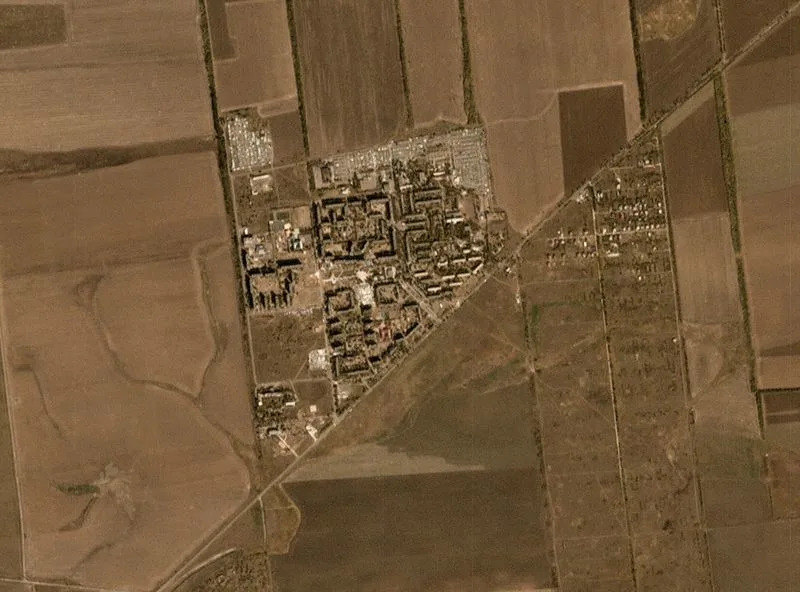
A satellite view of Vuhledar
By Guy Faulconbridge
Updated Wed, October 2, 2024
MOSCOW (Reuters) -Russian troops on Wednesday took charge of the eastern Ukrainian town of Vuhledar, a bastion that had resisted intense attacks since Russia launched its full-scale assault in 2022.
The advance of Moscow's forces, which control just under a fifth of Ukraine, has underlined Russia's vast superiority in men and materiel as Ukraine pleads for more weapons from the Western allies that have been supporting it.
Ukraine's eastern military command said it had ordered a pullback from the hilltop coal mining town to avoid encirclement by Russian troops and "preserve personnel and military equipment".
The Russian defence ministry did not mention Vuhledar in its daily battlefield report.
Russian Telegram channels, however, published video of troops waving the Russian tricolour flag over shattered buildings.
The town, which had a population of over 14,000 before the war, has been devastated, with Soviet-era apartment buildings smashed apart and scarred.
The Moskovsky Komsomolets newspaper said the last Ukrainian forces from the 72nd Mechanised Brigade, a unit famous for its resistance, had abandoned the town late on Tuesday.
President Vladimir Putin has said Russia's primary tactical goal is to take the whole of the Donbas region - the provinces of Donetsk and Luhansk - in southeastern Ukraine.
Russia controls about 80% of the Donbas, a heavy industry hub where the conflict began in 2014 when Moscow supported pro-Russian separatist forces after a pro-Russian president was toppled in Kyiv and Moscow seized Crimea from Ukraine.
VUHLEDAR TAKEN IN RAPID RUSSIAN ADVANCE
Since Russia sent its army into Ukraine in February 2022, the war has largely been a story of grinding artillery and drone strikes along a heavily fortified 1,000-km (620-mile) front involving hundreds of thousands of soldiers.
But in August the battlefield became much more dynamic: Ukraine smashed through the border in Russia's Kursk region in a bid to divert Russian forces, and Russian troops began advancing faster than before in eastern Ukraine.
Russian forces have been pushing westwards at key points along some 150 km (95 miles) of the front in the Donetsk region, with the logistics hub of Pokrovsk also a key target.
They captured Ukrainsk on Sept. 17 and then began encircling Vuhledar, about 80 km (50 miles) south of Pokrovsk.
Russia has been using pincer tactics to trap and then constrict Ukrainian strongholds. Images from the area showed intense bombardment of the town with artillery and aerial glide bombs.
Neither side discloses losses, and each said the other had paid a high human price for the town.
Control of Vuhledar, which lies at the intersection of the eastern and southern battlefields, is significant because it will ease Russia's advance as it tries to pierce deeper behind the Ukrainian defensive lines.
Russian bloggers said Russia could now try to push towards Velyka Novosilka, just over 30 km (20 miles) to the west.
Vuhledar also sits close to a railway line connecting Crimea to the Donbas region.
Russian forces currently control 98.5% of the Luhansk region and 60% of the Donetsk region.
(Editing by Mark Trevelyan and Kevin Liffey)
No comments:
Post a Comment